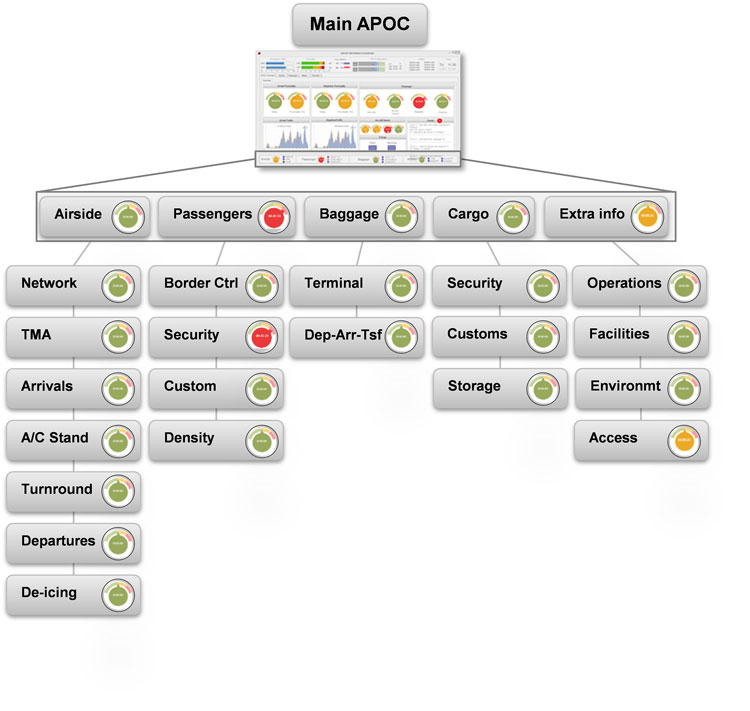SESAR2020 ‘PJ04 TAM’ overview
- Like
- Digg
- Del
- Tumblr
- VKontakte
- Buffer
- Love This
- Odnoklassniki
- Meneame
- Blogger
- Amazon
- Yahoo Mail
- Gmail
- AOL
- Newsvine
- HackerNews
- Evernote
- MySpace
- Mail.ru
- Viadeo
- Line
- Comments
- Yummly
- SMS
- Viber
- Telegram
- Subscribe
- Skype
- Facebook Messenger
- Kakao
- LiveJournal
- Yammer
- Edgar
- Fintel
- Mix
- Instapaper
- Copy Link
Posted: 6 July 2017 | Alan Marsden | No comments yet
The SESAR2020 ‘Total Airport Management’ Project, ‘PJ04 TAM’, formally started at the beginning of December 2016. The project team consists of 11 different consortia covering Airport Operators, Air Navigation Service Providers, Manufacturing Industry and Research Organisations as well as EUROCONTROL. Here, Alan Marsden, Project Manager at EUROCONTROL, delves deeper into the project; the first phase of which will take place over three years, concluding its activities at the end of 2019.


TAM is building on the work already performed in the area of Airport Operations Management during SESAR1 where focus was on developing and validating a number of key elements of the collaborative airport operations management concept. They centred essentially on operational planning, monitoring and management, and covered the following aspects:
- Definition and management of the Airport Operations Plan (AOP), the means by which different stakeholders have access to common shared information, dynamically updated over time
- Development of collaborative processes and toolsets associated with an Airport Operations Centre (APOC), a multi-stakeholder collaborative decision-making unit.
One of the four key focus areas of the SESAR2020 Work Programme is on ‘High Performing Airport Operations’ and the TAM project is an integral element thereof. As can be understood by the project title, TAM takes a ‘holistic’ view of all key airport operations processes – air and landside, aircraft, passengers, baggage etc. – and importantly, the interaction between them. The degree of synchronisation between these different processes constitutes a significant contributory factor to punctual and predictable operations and ultimately, therefore, passenger satisfaction.
Like all SESAR2020 Industrial R&D projects, TAM is structured around ‘SESAR Solutions’ which is particularly important from a deployment perspective. Each ‘Solution’ effectively constitutes a ‘package’ which stakeholders can deploy in order to reap the operational benefits that have been demonstrated during the project activity. The project is divided into two ‘Solutions’, the first with a focus on Performance Monitoring and the second on Performance Management.
TAM builds on the framework of Airport Collaborative Decision Making (A-CDM) which is essentially focusing on the aircraft (departure) process. ‘Solution 1’ will include the monitoring of landside processes – covering both passengers and baggage – to improve the predictability of the departure estimate. The aim is to provide holistic monitoring of key airport processes, notably aircraft, passengers and baggage, to ensure the maximum degree of synchronisation between each.
Our aim is for an airport that deploys ‘Solution 1’ of the TAM concept to be at the forefront of holistic process monitoring and fully integrated into the overall ATM network. Its operational community will have access to a rich data source in real-time through its ‘advanced’ AOP and it will be providing the network with high levels of predictability in relation to its flights.
‘Solution 2’ is focused on Performance Management, facilitated by access to real-time information captured in the form of performance dashboards that show ‘what has happened’, ‘what is happening’ and most importantly ‘what is predicted to happen’.
An airport that deploys ‘Solution 2’ of the TAM concept will be one at the forefront of performance-based management with operational decisions being made based on the information contained in high precision performance dashboards providing problem identification and performance prediction capabilities. The information being used by the airport in the decision-making processes will cover all key infrastructure elements and processes.
APOC and performance dashboard
The intention within the TAM concept is that different stakeholders share the same vision of the airport performance and that ‘root causes’ of potential problems can be identified and subsequently addressed by the most appropriate stakeholder(s) within a philosophy of Collaborative Decision Making.
For this concept to be realised, it is necessary that the different airport stakeholders have access to a ‘performance view’ and that problems can be detected as far in advance as possible to enable the problem management strategy to be predictive rather than reactive.
Different stakeholders will be provided with the most pertinent information to their operations and will have the ability to ‘drill-down’ in areas of particular interest enabling them to display lower level performance indicators to support informed decision-making. Whilst APOC dashboards will be highly customised to each airport they should provide a comprehensive overview of airport performance and probe individual airport processes.
For highly complex airports, the decision-making process could be reinforced by a ‘what-if’ function, allowing the impact of potential decisions to be assessed – the dashboard is the ideal vehicle for demonstrating such impact.
The design of a Performance Dashboard will be driven primarily by airport complexity and already known problem or bottleneck areas. Initial APOC dashboard work performed in SESAR1 – to be taken forward in the TAM project – is based at the highest level on the provision of an overall APOC view or ‘helicopter’ view of airport operations. The aim is to provide a clear representation of the current and predicted performance so that stakeholders can ensure that ‘everything is OK’.


Integration of the dashboard into the overall operations management process will be addressed in TAM. Not only will the project work with different airports on the design of the dashboard(s) but it will also consider the appropriate communication means – for instance by sharing information within a pre-defined group (message-oriented), or giving the option to provide on-line comments.
Big data
One area that is soliciting a lot of interest in airport operations management is the exploitation of considerable amounts of data recorded by airports and their partners in order to perform predictions of the behaviour of certain indicators.
At the end of SESAR1, EUROCONTROL initiated two feasibility studies with the airports of London Heathrow and Paris Charles de Gaulle focussing respectively on passenger transfer times and aircraft taxi-out times. Each study showed the great potential for machine learning techniques to be applied, based on the use of historic data to determine the underlying ‘drivers’ of those specific parameters of interest, the relative ‘weight’ of those drivers, and then enabling predictions of the parameter in question.
TAM will perform more research in this area and it is hoped that further simulation exercises will continue to demonstrate the benefits for all airport stakeholders – including the passenger – regarding the application of ‘big data’ and machine learning to predictive performance management.
Validation exercises
Fundamental to the success of the TAM project is the execution of a number of different validation activities in a range of airports from large to medium/small and regionals.
Validations will quantify the operational performance benefits of the different elements of the TAM concept. In order to do this, a number of different validation platforms or simulation environments will be employed allowing operational stakeholders to work with the concept – particularly the simulation of the multi-stakeholder/common shared data environment epitomised by the APOC.
Cyber aspects
The TAM concept and the APOC are reliant on the fusion of information coming from a number of different systems that are managed by different airport stakeholders. The integration of different systems, the exchange of large amounts of data – both locally and with the wider ATM network – together with multiple stakeholders and third parties, introduces specific requirements to address and mitigate cyber-threats.
In 2016, within the SESAR1 Programme, EUROCONTROL initiated a study in collaboration with Helios, the University of Glasgow and Groupe ADP to reflect specifically on the cyber issues associated to TAM and the future development of the APOC. The study identified that APOC/TAM effectiveness is intrinsically linked to the quality of data and systems that are exploited within the APOC.
Without addressing cyber-security, the success of TAM and APOC are at risk. Enhanced cyber-situational awareness in anticipation of cyber-attacks and effective collaboration between partners is critical.
During the definition of the TAM concept, and in collaboration with industrial partners, a security assessment will be performed on the tools/prototypes in order to identify system vulnerabilities and data security risks within a philosophy of ensuring – as far as possible – that the APOC is ‘safe by design’.
Applicability of the TAM concept across the airport community
Due to the high concentration of European air traffic on a relatively small number of airports, it is clear that any perturbation in one of these airports is not only likely to have a significant local impact, but could also have ramifications on the overall network. The TAM approach has most benefit in complex, busy hub airports and in areas where measures such as improved communication between the airports and the Network Manager can bring both local and network benefits.
However, TAM is not only about the major hub airports. The TAM concept will be designed to take account of the specific needs of smaller or regional airports by ensuring scalability as a function of the traffic and potential network impact. Such ‘regional’ airports are often key drivers of the local economy and it is important that there is not a ‘one size fits all’ approach.
One specific area that will be addressed is the feasibility of a ‘simplified’ and automated A-CDM milestone generation specifically catering for those airports that may consider the implementation and monitoring of A-CDM milestones to be cost prohibitive. Ultimately, the goal is to ensure that only those elements bringing most benefit at an affordable level will be implemented locally.
With regard to benefits, better or ‘more-targeted’ information sharing will lead to an increase in the predictability, flexibility and efficiency of airport operations. The more pro-active management of predicted impacts of non-optimal situations will lead to increased resilience through shorter and effective recovery to normal operations.
Summary
The TAM project is very ambitious in terms of its operational scope and the different validation activities that it intends to perform over what is a short timeframe for an R&D project. The vast experience and expertise contained within the project team means that we can be optimistic that tangible results will be delivered to the ultimate benefit of the travelling public.
Biography
Alan Marsden joined EUROCONTROL in 1995. His early years within the organisation were spent working on simulations contributing to the development of automated controller tools and strip-less ATC systems; the development of the European Capacity Planning process; and leading EUROCONTROL’s very first ‘Constraints to Growth’ project. More recently, Alan has led EUROCONTROL’s contribution to the Airport Operations Management concept in SESAR, as well as EUROCONTROL’s future contribution to the Total Airport Management project in SESAR2020.
Issue
Related topics
Airside operations, Information technology (IT), Terminal operations


















